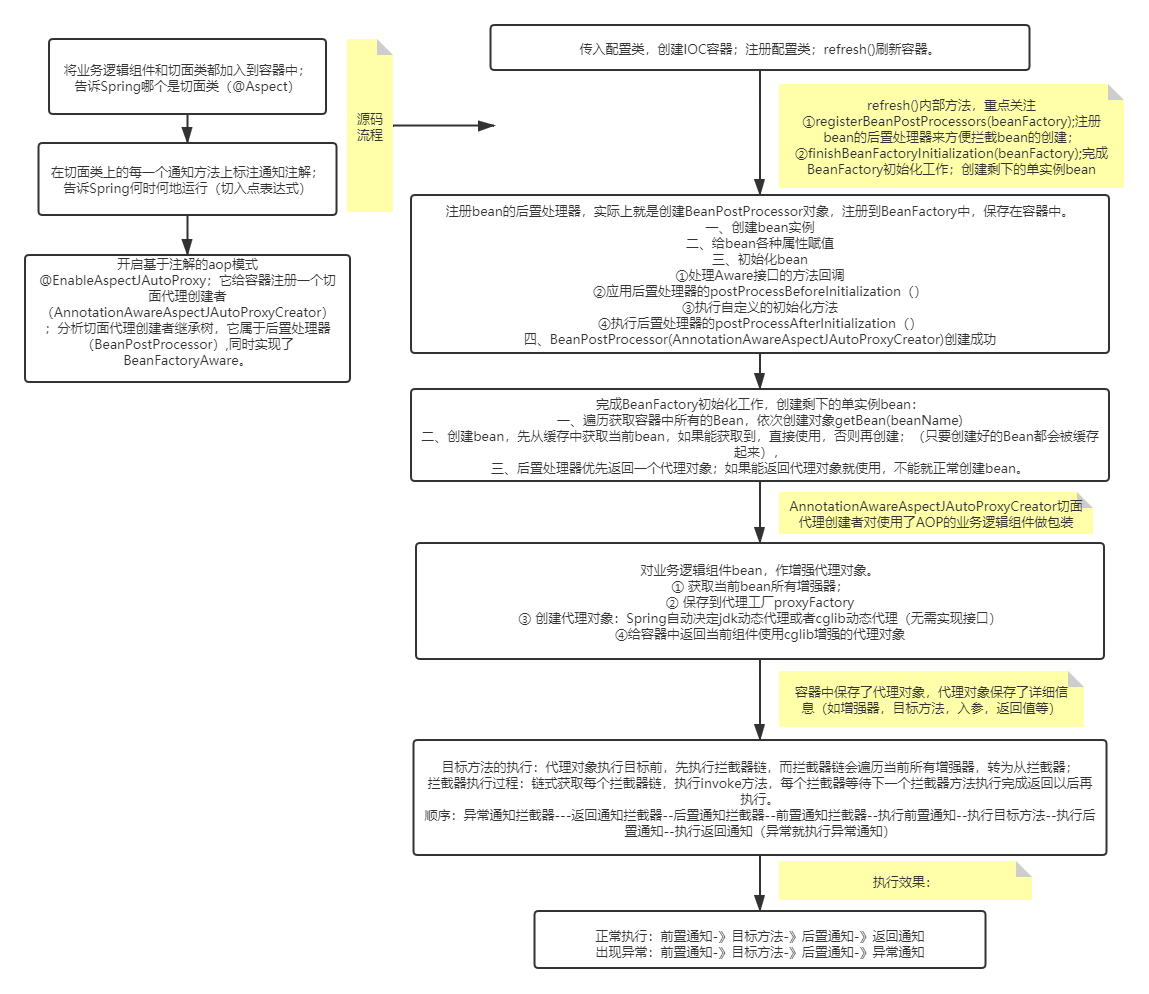重新学习Spring注解——AOP
面向切面编程——思想:在一个地方定义通用功能,但是可以通过声明的方式定义这个功能要以何种方式在何处运用,而无须修改受影响的类。
切面:横切关注点可以被模块化为特殊的类。
优点:
1、每个关注点都集中在一个地方,而不是分散到多出代码中;
2、服务模块更简洁,它只要关心核心功能,次要功能被转移到切面中了。
织入——把切面运用到目标对象并创建新的代理对象的过程。切面在指定的连接点被织入到目标对象中。在目标对象的生命周期里有多个点可以织入:
(1)、编译期 (2)、类加载期
(3)、运行期:切面在应用运行的某个时刻被织入。SpringAOP——为目标对象动态地创建一个代理对象 。
通过代理类的包裹切面,Spring在运行期把切面织入到Spring管理的bean中。代理类封装了目标类,并拦截被通知方法的调用,再把调用转发给真正的目标bean。当代理拦截到方法的调用时,再调用目标bean方法之前,会执行切面逻辑。
Spring只支持方法级别的连接点,不支持字段和构造器接入点。
27、AOP-AOP功能测试
@Aspect
public class LogAspects { //抽取公共的切入点表达式
//1、本类引用
//2、其他的切面引用
@Pointcut("execution(public int com.atguigu.aop.MathCalculator.*(..))")
public void pointCut(){}; //@Before在目标方法之前切入;切入点表达式(指定在哪个方法切入)
@Before("pointCut()")
public void logStart(JoinPoint joinPoint){
Object[] args = joinPoint.getArgs();
System.out.println(""+joinPoint.getSignature().getName()+"运行。。。@Before:参数列表是:{"+Arrays.asList(args)+"}");
} @After("com.atguigu.aop.LogAspects.pointCut()")
public void logEnd(JoinPoint joinPoint){
System.out.println(""+joinPoint.getSignature().getName()+"结束。。。@After");
} //JoinPoint一定要出现在参数表的第一位
@AfterReturning(value="pointCut()",returning="result")
public void logReturn(JoinPoint joinPoint,Object result){
System.out.println(""+joinPoint.getSignature().getName()+"正常返回。。。@AfterReturning:运行结果:{"+result+"}");
} @AfterThrowing(value="pointCut()",throwing="exception")
public void logException(JoinPoint joinPoint,Exception exception){
System.out.println(""+joinPoint.getSignature().getName()+"异常。。。异常信息:{"+exception+"}");
} }
public class MathCalculator {
public int div(int i,int j){
System.out.println("MathCalculator...div...");
return i/j;
}
}
@Test
public void test01(){
AnnotationConfigApplicationContext applicationContext = new AnnotationConfigApplicationContext(MainConfigOfAOP.class); //1、不要自己创建对象,否则无法执行AOP方法
// MathCalculator mathCalculator = new MathCalculator();
// mathCalculator.div(1, 1);
MathCalculator mathCalculator = applicationContext.getBean(MathCalculator.class);
mathCalculator.div(1, 0);
applicationContext.close();
}
28、[源码]-AOP原理-@EnableAspectJAutoProxy
29、[源码]-AOP原理-AnnotationAwareAspectJAutoProxyCreator分析
30、[源码]-AOP原理-注册AnnotationAwareAspectJAutoProxyCreator
31、[源码]-AOP原理-AnnotationAwareAspectJAutoProxyCreator执行时机
32、[源码]-AOP原理-创建AOP代理
33、[源码]-AOP原理-获取拦截器链-MethodInterceptor
34、[源码]-AOP原理-链式调用通知方法
35、[源码]-AOP-原理总结
/**
* AOP:【动态代理】
* 指在程序运行期间动态的将某段代码切入到指定方法指定位置进行运行的编程方式;
*
* 1、导入aop模块;Spring AOP:(spring-aspects)
* 2、定义一个业务逻辑类(MathCalculator);在业务逻辑运行的时候将日志进行打印(方法之前、方法运行结束、方法出现异常,xxx)
* 3、定义一个日志切面类(LogAspects):切面类里面的方法需要动态感知MathCalculator.div运行到哪里然后执行;
* 通知方法:
* 前置通知(@Before):logStart:在目标方法(div)运行之前运行
* 后置通知(@After):logEnd:在目标方法(div)运行结束之后运行(无论方法正常结束还是异常结束)
* 返回通知(@AfterReturning):logReturn:在目标方法(div)正常返回之后运行
* 异常通知(@AfterThrowing):logException:在目标方法(div)出现异常以后运行
* 环绕通知(@Around):动态代理,手动推进目标方法运行(joinPoint.procced())
* 4、给切面类的目标方法标注何时何地运行(通知注解);
* 5、将切面类和业务逻辑类(目标方法所在类)都加入到容器中;
* 6、必须告诉Spring哪个类是切面类(给切面类上加一个注解:@Aspect)
* [7]、给配置类中加 @EnableAspectJAutoProxy 【开启基于注解的aop模式】
* 在Spring中很多的 @EnableXXX;
*
* 三步:
* 1)、将业务逻辑组件和切面类都加入到容器中;告诉Spring哪个是切面类(@Aspect)
* 2)、在切面类上的每一个通知方法上标注通知注解,告诉Spring何时何地运行(切入点表达式)
* 3)、开启基于注解的aop模式;@EnableAspectJAutoProxy
*
* AOP原理:【看给容器中注册了什么组件,这个组件什么时候工作,这个组件的功能是什么?】
* @EnableAspectJAutoProxy;
* 1、@EnableAspectJAutoProxy是什么?
* @Import(AspectJAutoProxyRegistrar.class):给容器中导入AspectJAutoProxyRegistrar
* 利用AspectJAutoProxyRegistrar自定义给容器中注册bean;BeanDefinetion
* internalAutoProxyCreator=AnnotationAwareAspectJAutoProxyCreator
*
* 给容器中注册一个AnnotationAwareAspectJAutoProxyCreator;
*
* 2、 AnnotationAwareAspectJAutoProxyCreator:
* AnnotationAwareAspectJAutoProxyCreator
* ->AspectJAwareAdvisorAutoProxyCreator
* ->AbstractAdvisorAutoProxyCreator
* ->AbstractAutoProxyCreator
* implements SmartInstantiationAwareBeanPostProcessor, BeanFactoryAware
* 关注后置处理器(在bean初始化完成前后做事情)、自动装配BeanFactory
*
* AbstractAutoProxyCreator.setBeanFactory()
* AbstractAutoProxyCreator.有后置处理器的逻辑;
*
* AbstractAdvisorAutoProxyCreator.setBeanFactory()-》initBeanFactory()
*
* AnnotationAwareAspectJAutoProxyCreator.initBeanFactory()
*
*
* 流程:
* 1)、传入配置类,创建ioc容器
* 2)、注册配置类,调用refresh()刷新容器;
* 3)、registerBeanPostProcessors(beanFactory);注册bean的后置处理器来方便拦截bean的创建;
* 1)、先获取ioc容器已经定义了的需要创建对象的所有BeanPostProcessor
* 2)、给容器中加别的BeanPostProcessor
* 3)、优先注册实现了PriorityOrdered接口的BeanPostProcessor;
* 4)、再给容器中注册实现了Ordered接口的BeanPostProcessor;
* 5)、注册没实现优先级接口的BeanPostProcessor;
* 6)、注册BeanPostProcessor,实际上就是创建BeanPostProcessor对象,保存在容器中;
* 创建internalAutoProxyCreator的BeanPostProcessor【AnnotationAwareAspectJAutoProxyCreator】
* 1)、创建Bean的实例
* 2)、populateBean;给bean的各种属性赋值
* 3)、initializeBean:初始化bean;
* 1)、invokeAwareMethods():处理Aware接口的方法回调
* 2)、applyBeanPostProcessorsBeforeInitialization():应用后置处理器的postProcessBeforeInitialization()
* 3)、invokeInitMethods();执行自定义的初始化方法
* 4)、applyBeanPostProcessorsAfterInitialization();执行后置处理器的postProcessAfterInitialization();
* 4)、BeanPostProcessor(AnnotationAwareAspectJAutoProxyCreator)创建成功;--》aspectJAdvisorsBuilder
* 7)、把BeanPostProcessor注册到BeanFactory中;
* beanFactory.addBeanPostProcessor(postProcessor);
* =======以上是创建和注册AnnotationAwareAspectJAutoProxyCreator的过程========
*
* AnnotationAwareAspectJAutoProxyCreator => InstantiationAwareBeanPostProcessor
* 4)、finishBeanFactoryInitialization(beanFactory);完成BeanFactory初始化工作;创建剩下的单实例bean
* 1)、遍历获取容器中所有的Bean,依次创建对象getBean(beanName);
* getBean->doGetBean()->getSingleton()->
* 2)、创建bean
* 【AnnotationAwareAspectJAutoProxyCreator在所有bean创建之前会有一个拦截,InstantiationAwareBeanPostProcessor,会调用postProcessBeforeInstantiation()】
* 1)、先从缓存中获取当前bean,如果能获取到,说明bean是之前被创建过的,直接使用,否则再创建;
* 只要创建好的Bean都会被缓存起来
* 2)、createBean();创建bean;
* AnnotationAwareAspectJAutoProxyCreator 会在任何bean创建之前先尝试返回bean的实例
* 【BeanPostProcessor是在Bean对象创建完成初始化前后调用的】
* 【InstantiationAwareBeanPostProcessor是在创建Bean实例之前先尝试用后置处理器返回对象的】
* 1)、resolveBeforeInstantiation(beanName, mbdToUse);解析BeforeInstantiation
* 希望后置处理器在此能返回一个代理对象;如果能返回代理对象就使用,如果不能就继续
* 1)、后置处理器先尝试返回对象;
* bean = applyBeanPostProcessorsBeforeInstantiation():
* 拿到所有后置处理器,如果是InstantiationAwareBeanPostProcessor;
* 就执行postProcessBeforeInstantiation
* if (bean != null) {
bean = applyBeanPostProcessorsAfterInitialization(bean, beanName);
}
*
* 2)、doCreateBean(beanName, mbdToUse, args);真正的去创建一个bean实例;和3.6流程一样;
* 3)、
*
*
* AnnotationAwareAspectJAutoProxyCreator【InstantiationAwareBeanPostProcessor】 的作用:
* 1)、每一个bean创建之前,调用postProcessBeforeInstantiation();
* 关心MathCalculator和LogAspect的创建
* 1)、判断当前bean是否在advisedBeans中(保存了所有需要增强bean)
* 2)、判断当前bean是否是基础类型的Advice、Pointcut、Advisor、AopInfrastructureBean,
* 或者是否是切面(@Aspect)
* 3)、是否需要跳过
* 1)、获取候选的增强器(切面里面的通知方法)【List<Advisor> candidateAdvisors】
* 每一个封装的通知方法的增强器是 InstantiationModelAwarePointcutAdvisor;
* 判断每一个增强器是否是 AspectJPointcutAdvisor 类型的;返回true
* 2)、永远返回false
*
* 2)、创建对象
* postProcessAfterInitialization;
* return wrapIfNecessary(bean, beanName, cacheKey);//包装如果需要的情况下
* 1)、获取当前bean的所有增强器(通知方法) Object[] specificInterceptors
* 1、找到候选的所有的增强器(找哪些通知方法是需要切入当前bean方法的)
* 2、获取到能在bean使用的增强器。
* 3、给增强器排序
* 2)、保存当前bean在advisedBeans中;
* 3)、如果当前bean需要增强,创建当前bean的代理对象;
* 1)、获取所有增强器(通知方法)
* 2)、保存到proxyFactory
* 3)、创建代理对象:Spring自动决定
* JdkDynamicAopProxy(config);jdk动态代理;
* ObjenesisCglibAopProxy(config);cglib的动态代理;
* 4)、给容器中返回当前组件使用cglib增强了的代理对象;
* 5)、以后容器中获取到的就是这个组件的代理对象,执行目标方法的时候,代理对象就会执行通知方法的流程;
*
*
* 3)、目标方法执行 ;
* 容器中保存了组件的代理对象(cglib增强后的对象),这个对象里面保存了详细信息(比如增强器,目标对象,xxx);
* 1)、CglibAopProxy.intercept();拦截目标方法的执行
* 2)、根据ProxyFactory对象获取将要执行的目标方法拦截器链;
* List<Object> chain = this.advised.getInterceptorsAndDynamicInterceptionAdvice(method, targetClass);
* 1)、List<Object> interceptorList保存所有拦截器 5
* 一个默认的ExposeInvocationInterceptor 和 4个增强器;
* 2)、遍历所有的增强器,将其转为Interceptor;
* registry.getInterceptors(advisor);
* 3)、将增强器转为List<MethodInterceptor>;
* 如果是MethodInterceptor,直接加入到集合中
* 如果不是,使用AdvisorAdapter将增强器转为MethodInterceptor;
* 转换完成返回MethodInterceptor数组;
*
* 3)、如果没有拦截器链,直接执行目标方法;
* 拦截器链(每一个通知方法又被包装为方法拦截器,利用MethodInterceptor机制)
* 4)、如果有拦截器链,把需要执行的目标对象,目标方法,
* 拦截器链等信息传入创建一个 CglibMethodInvocation 对象,
* 并调用 Object retVal = mi.proceed();
* 5)、拦截器链的触发过程;
* 1)、如果没有拦截器执行执行目标方法,或者拦截器的索引和拦截器数组-1大小一样(指定到了最后一个拦截器)执行目标方法;
* 2)、链式获取每一个拦截器,拦截器执行invoke方法,每一个拦截器等待下一个拦截器执行完成返回以后再来执行;
* 拦截器链的机制,保证通知方法与目标方法的执行顺序;
*
* 总结:
* 1)、 @EnableAspectJAutoProxy 开启AOP功能
* 2)、 @EnableAspectJAutoProxy 会给容器中注册一个组件 AnnotationAwareAspectJAutoProxyCreator
* 3)、AnnotationAwareAspectJAutoProxyCreator是一个后置处理器;
* 4)、容器的创建流程:
* 1)、registerBeanPostProcessors()注册后置处理器;创建AnnotationAwareAspectJAutoProxyCreator对象
* 2)、finishBeanFactoryInitialization()初始化剩下的单实例bean
* 1)、创建业务逻辑组件和切面组件
* 2)、AnnotationAwareAspectJAutoProxyCreator拦截组件的创建过程
* 3)、组件创建完之后,判断组件是否需要增强
* 是:切面的通知方法,包装成增强器(Advisor);给业务逻辑组件创建一个代理对象(cglib);
* 5)、执行目标方法:
* 1)、代理对象执行目标方法
* 2)、CglibAopProxy.intercept();
* 1)、得到目标方法的拦截器链(增强器包装成拦截器MethodInterceptor)
* 2)、利用拦截器的链式机制,依次进入每一个拦截器进行执行;
* 3)、效果:
* 正常执行:前置通知-》目标方法-》后置通知-》返回通知
* 出现异常:前置通知-》目标方法-》后置通知-》异常通知
*
*
*
*/
流程图总结:

重新学习Spring注解——AOP的更多相关文章
- 跟着刚哥学习Spring框架--AOP(五)
AOP AOP(Aspect Oriented Programming),即面向切面编程,可以说是OOP(Object Oriented Programming,面向对象编程)的补充和完善.OOP引入 ...
- Spring注解 - AOP 面向切面编程
基本概念: AOP:Aspect Oriented Programming,即面向切面编程 指在程序运行期间动态的将某段代码切入到指定方法指定位置进行运行的编程方式 前置通知(@Before):在目标 ...
- spring学习 十三 注解AOP
spring 不会自动去寻找注解,必须告诉 spring 哪些包下的类中可能有注解,也就是要开启注解扫描,注解的包是spring-context.jar,所以在配置文件中还要引入context约束,也 ...
- 基于spring注解AOP的异常处理
一.前言 项目刚刚开发的时候,并没有做好充足的准备.开发到一定程度的时候才会想到还有一些问题没有解决.就比如今天我要说的一个问题:异常的处理.写程序的时候一般都会通过try...catch...fin ...
- Spring注解AOP及单元测试junit(6)
2019-03-10/20:19:56 演示:将xml配置方式改为注解方式 静态以及动态代理推荐博客:https://blog.csdn.net/javazejian/article/details/ ...
- 学习 Spring (十三) AOP 配置
Spring入门篇 学习笔记 Spring 所有的切面和通知器都必须放在一个 内(可以配置包含多个 元素),每一个 可以包含 pointcut, advisor 和 aspect 元素(它们必须按照这 ...
- spring 注解AOP
aspectAnnotation的切面信息,加到了AnnotationAwareAspectJAutoProxyCreator的advisorsCache属性里面去了. 解析annotationSe ...
- 重新学习Spring注解——Spring容器
44.[源码]-Spring容器创建-BeanFactory预准备 45.[源码]-Spring容器创建-执行BeanFactoryPostProcessor 46.[源码]-Spring容器创建-注 ...
- spring注解 aop
@Resource(name="as") 为空按类型装配 @autowired 按类型 @quafiler (name="xx") 按名称 spring继承关 ...
随机推荐
- [LeetCode] 19. Remove Nth Node From End of List 移除链表倒数第N个节点
Given a linked list, remove the nth node from the end of list and return its head. For example, Give ...
- RabbitMQ操作代码封装
1.Message.cs using System; using System.Collections.Generic; using System.Linq; using System.Text; u ...
- ORA-12528: TNS:listener: all appropriate instances are blocking new connections
Oracle问题:ORA-12528: TNS: 监听程序: 所有适用例程都无法建立新连接 问题原始描述: ORA-12528: TNS:listener: all appropriate insta ...
- 调试MATLAB代码
1.在子函数设置的断点,在运行时,不起作用: 因为在主函数开始时,使用了clear all,在运行时,会把断点给删除.
- (算法)LeetCode刷题
LeetCode 56 合并区别 Given [1,3],[2,6],[8,10],[15,18], return [1,6],[8,10],[15,18]. 关键就是a[1]>=b[0] 也就 ...
- [转帖]编写shell脚本所需的语法和示例
编写shell脚本所需的语法和示例 https://blog.csdn.net/CSDN___LYY/article/details/100584638 在说什么是shell脚本之前,先说说什么是sh ...
- struts2拦截器的实现机制
前言 最近老大让每周写一篇技术性的博客,想想也没啥写,就想着随便拿个以前的项目去研究研究五大框架的底层代码.本人水平有限,有不对的地方还望大家勿喷,指正! 开始之前先了解下strtus2的工作流程: ...
- web api与mvc的区别
MVC主要用来构建网站,既关心数据也关心页面展示,而Web API只关注数据 Web API支持格式协商,客户端可以通过Accept header通知服务器期望的格式 Web API支持Self Ho ...
- 整理:C#常用字符串操作,常用数值类型转换
一.字符串操作 1. 字符串连接 //将指定的数组所有元素拼接为一个字符串 string[] arr = {"A","B","C"}; st ...
- Python - 解释器 - 第三天
Python解释器 安装好Python3.x之后,我们可以使用文本文件去编写Python代码,编写完成后将扩展名改成.py结尾的文本文件. 想要执行编写好的.py文件就需要用到Python解释器. 解 ...
